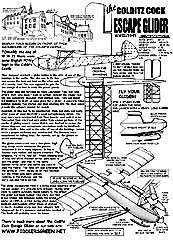
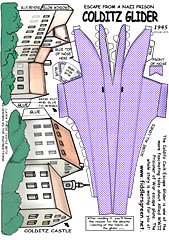
Colditz Escape Glider - $$7.95
The glider was assembled by Goldfinch and Best and 12 assistants known as "apostles", in the lower attic above the chapel. The runway was to be constructed from tables and the glider was to be launched using a pulley system based on a falling metal bathtub full of concrete, using a gravity-assisted acceleration to 30 mph (50 km/h).
The Colditz Cock Prison Escape Glider
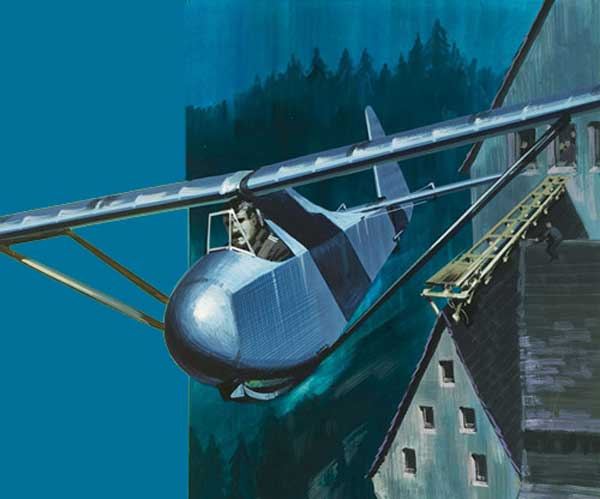
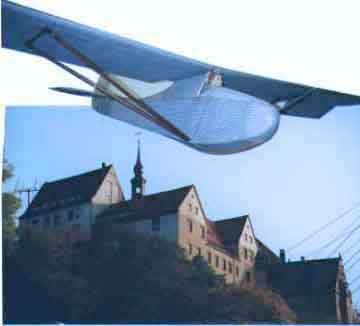
Toward the end of WW.II there were some English prisoners of War kept in the Colditz castle. They designed and built a glider hidden in the attic of one of the buildings in the castle. The idea was to fly two men across the town and land on the other side of a nearby river This was supposed to give the two enough of a lead to avoid the prison guards.
The war was winding down and Allied command told all prisoners to stop trying to escape as they were being summarily shot when re-captured. It was obvious who was going to win the war by then so it was only a matter of time before the prisoners would be rescued.
Thought you might like to see a pic of the birthday cake I made for my dad featuring the Colditz glider, (first miniaturized on a postcard), flying
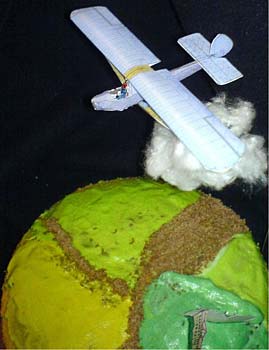 above
a cake of fields. I mounted the hastily constructed glider
on welding wire so that it flew a good 6" above the cake,
then disguised the wire with clouds of cotton wool. :-) Peter
Eveleigh (see photo right)
above
a cake of fields. I mounted the hastily constructed glider
on welding wire so that it flew a good 6" above the cake,
then disguised the wire with clouds of cotton wool. :-) Peter
Eveleigh (see photo right)Dear Fiddlers Green, ...It looks like you've taken the art of paper model design yet another giant step ahead. My 10 year old son just built it and is anxious to bring it in to school as a 'show and tell'. Not only has he gained confidence creating his own model, he's bubbling over with all the information he got from your incredible web site. Enclosed is an order for the light house my wife has been wanting.. Keep 'em coming, please!!!!. Frank S
Sir....I have just read your web site on the paper model of the Colditz Glider. I am sending you this because today for the second time, I spent some time talking with Bill Goldfinch at Old Sarum Flying Club just north of Salisbury in the county of Wiltshire, England. You could probably guess what Bill is doing with him self these days, yes, he is building yet another aircraft from scrap wood. It is a marvel too. Not content with something simple such as a glider, or even a single engine land plane, Bill is constructing an amphibious monoplane.
I met Bill first by chance last June when I was forced to land my ultra light at Old Sarum due to bad weather. I was permitted to put my aircraft in the corner of a large hanger - itself an historical relic - built by Italian POW's. Tucked in the same corner of the hanger was Bill and the component parts of his plane. Today I happened to be in Salisbury and made a point of calling to see how he was getting on. The fuselage is 90% complete as are the wings and the main float. The retractable landing gear is operational.
Currently Bill is working on the construction of the tail plane and rudder. Half an engine has be scrounged, a propeller has been donated and the fabric to cover the fuselage and wings has been snatched from the rubbish having been cast of a Jodel that had been recovered Bill is about 85 and it would seem that outside of the Old Sarum Flying Club, little is known of his current endeavours.He is a wonderfully alert and conversational chap with an enormous wealth of aeronautical knowledge. He lost his flying licence some years ago apparently, in the UK medical requirements are tough as one gets older. So when I asked him about the possibility of his sea plane flying he said that it was, of course, only a full scale mock-up for which nor certification would ever be sought,however he does intend to do some taxiing trials on water "...if it lifts off when I open the throttle then I guess I will have to fly it...." he says. It is a puzzle what the Civil Aviation Authority will have to say - but how do you sanction an 85 year old??I figure you may appreciate this little tale. Thanks for your research and paper. Bye bye Graham Webster
Absolutely beautiful -- the checked fabric is a hoot!Look forward to building this when life calms down a bit. J Cookson 4/13/01
The addition of the tiny Colditz Castle was a stroke of genius. The aircraft itself looks great. Huzzah for the Sparks-Fyn Aircraft Company/ RM 4/13/01
What a cool new format. Instructions on the model page and the castle backdrop is a real hoot too. CG4/14/01
--Zie Colditz ist vunderbar! I must say, awld chap, yew hav dun it unce mower! Duckpond 4/14/01
Dear Fiddlers Green, ...It looks like you've taken the art of paper model design yet another giant step ahead.. My son 10 year old son just built it and is anxious to bring it in to school as a 'show and tell'. Not only has he gained confidence creating his own model, he's bubbling over with all the information he got from your incredible web site. Enclosed is an order for the light house my wife has been wanting.. Keep 'em coming, please!!!!. Frank S (4,14, 01)
A quick note to thank you and your dedicated designers and testers. Thanking you is a bit of an understatement but given the privilege of this magic key and the incredible models, it's an action that I hope conveys my enjoyment.
The Colditz glider was in my mind extraordinary as I feel I was given 2 models instead of one. The diorama is invaluable for me. Not as a "stick on the back of the glider" but to provide a valuable part of the background in my photography/display or your model. Given that being isolated, photography/display is becoming my method to show others, my models. I provide this idea for feedback and given that you provided this small diorama instead of a splash picture I though it would need no more effort to give a unique extra feature to your designs. In conclusion I suggest you exploit the idea for sales if the next few months turnover are never that good. Take care and thanks again, Peter H (4, 01)
Hi Chip ,,Great to find your web site. Started
with the grandchildren Jacob and Joshua on the models -
they met Bill Goldfinch the Colditz Glider builder last
month at Old Sarum airfield -and then we ran a search on
internet and found you..Bill told them of his wartime exploits
and yes we viewed the progress on his - new - amphibian.
It's apparently a Grover Loening - yes its
spelt oe ! - It looks like a good subject for a future paper
model, great story both historical and present with Bills
almost unknown build. If it is that type, the Pan American
trip they made could lead modelers to build a model for
each US cities represented. One is at USAF museum
I believe - the San Francisco. His story also includes a
Sunderland - they crashed in Crete in WW2 and then he was
taken prisoner. Mike Slade
Hope you got the Colditz Glider cards signed by the Designer - Bill Goldfinch.
Later this month I am taking the primary school children on a visit to the local Museum at Bournemouth Airport, UK. Worth a check on their web site! Also doing a model and slide show for them. Will offer them a card Colditz Glider each and recommend your site. All the best mate, Michael Slade
The Colditz Glider
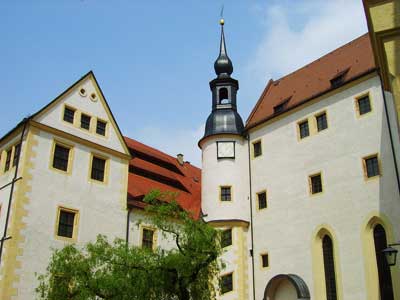 To right of tower: Chapel roof from the Inner Courtyard. The glider was built in the left hand, western end of the upper attic. |
Readers of Soaring may recall the television movie "The
Birdmen" in which Allied POW's constructed a glider and launched
it from the rooftop of the German castle used to imprison them.
What you may not know is there actually was such a glider, constructed
by British officers held captive in Colditz Castle during WWII.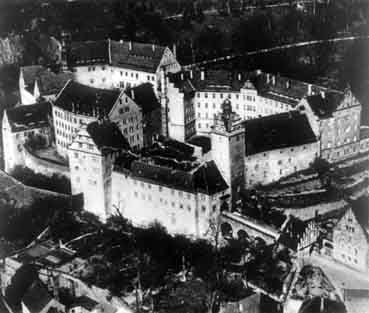
Colditz castle was the German "Supermax." RAF prisoners like Jack Best, Walter Morison, and Lorne Welch, recaptured after escaping from other POW camps were transferred to the supposedly inescapable Colditz. Colditz had the distinction of being the only German POW camp that had more guards than prisoners. Nevertheless, Allied prisoners continued to tunnel, jump, and sneak their way out of "The Colditz Escape Academy" in surprising numbers.
Putting so many experienced escapees all in one place turned out to be a rather questionable idea. As time went by, more and more conventional avenues of escape were sealed off by the Germans. Tunneling became all but impossible with the installation of sophisticated sound monitors. Never the less, prisoners refused to accept the idea that Colditz was inescapable. Even in the early parts of 1945 some POW's managed to escape, albeit by ever riskier routes, such as by being catapulted out of high windows. Even one "home run" raised morale considerably among the remaining prisoners. It was about this time that Colditz "Heavy Industries Inc." was founded, to design and build a glider.
|
|
The glider idea was hatched by Navy Lieutenant Tony Rolt and others. Rolt, who wasn't even an airman, noticed the chapel roof line was completely obscured from German view. Tony convinced Bill Goldfinch to draft up some plans for a glider. A concrete filled bathtub plunging five stories and then crashing into the floor would provide the catapult needed for launch.

Hundreds of ribs had to be constructed, from bed slats and every other piece of wood the POW's could surreptitiously obtain. The wing spars were be constructed from floor boards, and control wires fabricated from electrical wire stolen from unused portions of the castle. A gliding expert, Lorne Welch, was drafted to review the stress diagrams and aerodynamic calculations made by Goldfinch. POW's built a false wall in the attic of one of the buildings, behind which a proper workshop was constructed. The Germans were accustomed to looking down, for tunnels, not up, for gliders or secret workshops. No less than 12 primary lookouts, or "stooges" and an electric alarm system was used to warn the builders of approaching guards, requiring silence and a work stoppage.
The glider constructed was a two-place, high wing design which resembles the popular Schweizer 2-33 in many aspects. It has a Mooney style rudder and square elevators. The wingspan, tip to tip, was 32'. Prison sleeping bags of blue and white checked cotton were used to skin the glider, and true to the movie, German ration millet was boiled and used to dope the fabric. The take-off was scheduled for the spring of 1945, during an air raid blackout. But the Allied guns were already rumbling in the distance, and the war's outcome fairly certain. The British escape officer decided the launch should be delayed in case the SS ordered the massacre of the prisoners, as a way to get a message out to approaching American troops. Instructions from Britain had already called for a halt to all escape efforts, since by this time the Germans had begun shooting escapees on the spot.
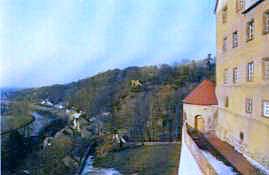 Following the peaceful turnover of the camp from the Kommandant
to the Senior British Officer word of the glider's existence was
put out. The glider was assembled and put on display for the prisoners
and liberating American GI's. Dozens of prisoners had helped in
it's construction, by building tools, or parts for the glider,
or by stooging. An unnamed GI took the only photo of the glider
known to exist, shown here. The "Colditz Cock" was then
disassembled and lifted back into it's hiding place at war's end.
Following the peaceful turnover of the camp from the Kommandant
to the Senior British Officer word of the glider's existence was
put out. The glider was assembled and put on display for the prisoners
and liberating American GI's. Dozens of prisoners had helped in
it's construction, by building tools, or parts for the glider,
or by stooging. An unnamed GI took the only photo of the glider
known to exist, shown here. The "Colditz Cock" was then
disassembled and lifted back into it's hiding place at war's end.
The glider disappeared from it's hiding place sometime after the war ended, it's ultimate fate unknown. During later visits to Colditz survivors heard rumors to the effect the glider had been burned. One story was that it was broken into firewood during the brutal winter of 1945-6, a time during which many Germans and Russians either froze or starved to death. Another story was that villagers felt "disgraced" by it's presence and publicly torched it. The truth will probably never be known, unless some of the Russians soldiers who occupied the town immediately after the war come forward.
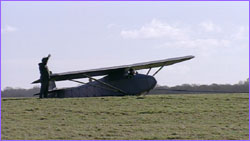 |
 |
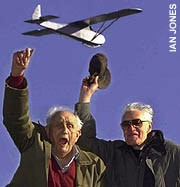 |
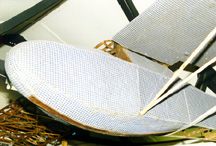 |
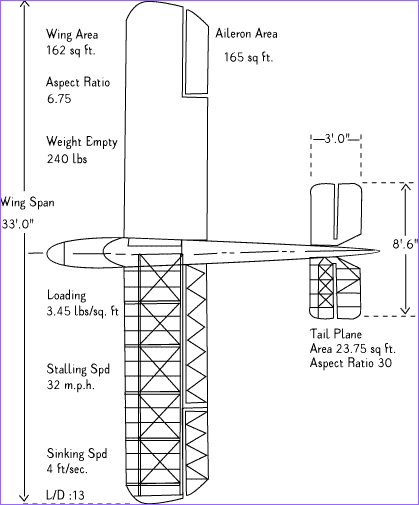
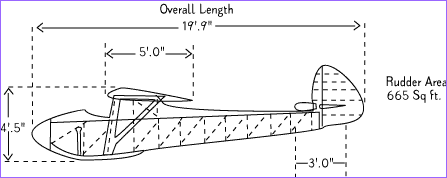 On a snowy day in December, 1943, while he looked out over
the German town of Colditz, POW Bill Goldfinch noticed snowflakes
outside his window drifting upward. Perhaps it would be possible,
he thought, to escape from the prison in a glider. The updraft
would help in getting the glider airborne. Also, there was an ideal
area from which to launch a glider:the castle's chapel roof, which
was hidden from the guards' watchful eyes. The prisoners could
use ropes, pulleys, and a counterweight to propel the glider along
the roof.
On a snowy day in December, 1943, while he looked out over
the German town of Colditz, POW Bill Goldfinch noticed snowflakes
outside his window drifting upward. Perhaps it would be possible,
he thought, to escape from the prison in a glider. The updraft
would help in getting the glider airborne. Also, there was an ideal
area from which to launch a glider:the castle's chapel roof, which
was hidden from the guards' watchful eyes. The prisoners could
use ropes, pulleys, and a counterweight to propel the glider along
the roof.
Goldfinch presented his idea to Dick Howe, head of 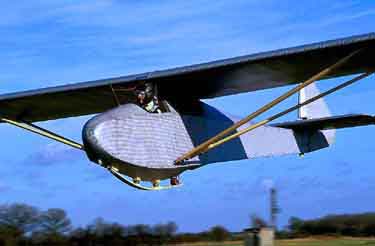 the prison's escape committee,
who approved it. Goldfinch's friend, Jack Best, was also assigned
to the project. Using a textbook discovered in the prison library,
Goldfinch and Best, both engineers, worked out the specifications
for a glider. It would carry a pilot and one passenger. The wings
would have enough lift to carry the glider's occupants over the
town of Colditz -- more than 300 feet below -- and across the
River Mulde. Goldfinch then drew up the plans.
the prison's escape committee,
who approved it. Goldfinch's friend, Jack Best, was also assigned
to the project. Using a textbook discovered in the prison library,
Goldfinch and Best, both engineers, worked out the specifications
for a glider. It would carry a pilot and one passenger. The wings
would have enough lift to carry the glider's occupants over the
town of Colditz -- more than 300 feet below -- and across the
River Mulde. Goldfinch then drew up the plans.
Goldfinch and Best began building the glider in their rooms. This, of course, could only be temporary since it would be impossible to hide such a large project from the guards. So in one of the castle's attics -- the one adjacent to the roof slated for the runway -- prisoners created a workshop. Using shutters and mud made from attic dust, they constructed a false wall at one end of the attic, giving the glider builders a small space that could accommodate the largest of the disassembled glider pieces. When they were finished, anyone who went into the main part of the attic saw a convincing false wall at one end and no indication that the attic was eight feet shorter than before. To gain access to the shop, the prisoners also built a trapdoor in the shop's floor.
The materials needed to fashion the tools and glider were for the most part scavenged. The prisoners made a plane from a table knife, drills from nails, saw handles from bed boards, and saw blades from both a wind-up record player's spring and the frame around iron window bars.For the glider's control wires they appropriated electrical wire taken from unused areas of the castle.
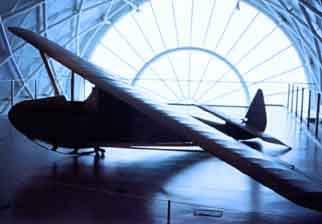
For the wings' spars (main supports) and ribs they availed themselves
of floorboards and bed slats, respectively. And to cover the glider's
wooden frame they used bed sheets, which they doped with hot millet
(part of their rations) to stiffen the fabric. They obtained a
few items through bribery: casein glue and a metal drill, for
example. Constructing the glider's parts was tedious, to say the
least. For the wings alone the builders had to craft over 6,000
hand-fashioned pieces. To make just one rib,they had to shape
a piece of wood, steam it to render it pliable, bend and pin it,
then finally glue it into place. And the glider required hundreds
of these.
Takeoff was finally scheduled for the spring of 1945. The plan was to assemble the aircraft, then catapult it off the chapel's roof using a metal bathtub filled with concrete as ballast. The tub would fall five stories. The glider would then sail out silently over the town of Colditz, giving its occupants a good head start over the German guards, who would soon discover a bathtub in the yard and two prisoners missing.
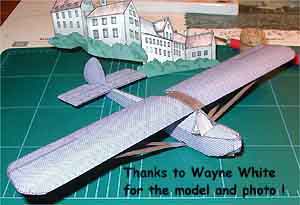 Wayne is an Official Beta Builder and ....wait till you see the FLYING JEEP he designed!!! |
|
Side-framed saw |
Several books have been written about Colditz, including one by the head of the German guards, Hauptmann Eggers. Many of the men imprisoned at Colditz are still alive today, and there is a quite active "Colditz Association." Lorne Welch had a long and active role in soaring after the war, writing several books on the subject. A British television station was finally able to produce a documentary on Colditz after the Berlin Wall fell. The producer took five of the former prisoners back to the Castle and re-enacted several of the more notorious escapes.
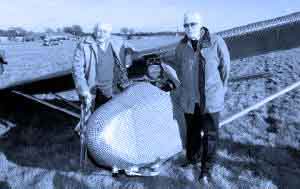 The Colditz story has been retold over the years in Flying
, Reader's Digest, and in Soaring. The article in Flying inspired
producer Harve Bennett to produce the American television movie,
"The Birdmen." American Walter Leschander is responsible
for finding the only existing photo of the glider, reproduced
here, which the prisoners themselves had never seen until sometime
around 1970. Leschander located a copy of the photo in the possession
of the commanding officer of the GI who had taken it, whose name,
and fate has vanished into history. (Company 1, 273 Regiment,
69th Infantry under Lee Shaughnessy) American Don Berliner researched
the Colditz Glider in the '70s, but this article for Air&
Space was never published.
The Colditz story has been retold over the years in Flying
, Reader's Digest, and in Soaring. The article in Flying inspired
producer Harve Bennett to produce the American television movie,
"The Birdmen." American Walter Leschander is responsible
for finding the only existing photo of the glider, reproduced
here, which the prisoners themselves had never seen until sometime
around 1970. Leschander located a copy of the photo in the possession
of the commanding officer of the GI who had taken it, whose name,
and fate has vanished into history. (Company 1, 273 Regiment,
69th Infantry under Lee Shaughnessy) American Don Berliner researched
the Colditz Glider in the '70s, but this article for Air&
Space was never published.
Colditz Castle was reportedly used after the war as a hospital for Russian officers, and has since fallen into serious disrepair. It is now owned by the State of Saxony, and is in desperate need of funding for restoration. Presently a small museum exists, with such exhibits as the universal lock pick designed by the British to open the supposedly "impenetrable" German locks - two of which supposedly prevented access to room below where the glider was being built, through which access to the trapdoor to the secret workshop was gained.
Specifications for the Colditz Cock Glider
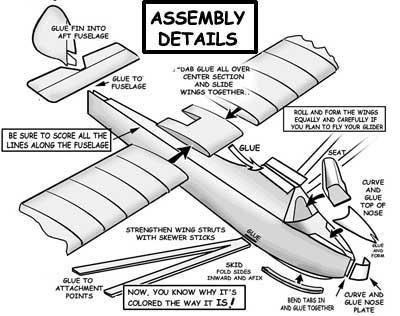 |
Crew: One pilot
Performace |
Link to a Colditz game called "Skedaddle"



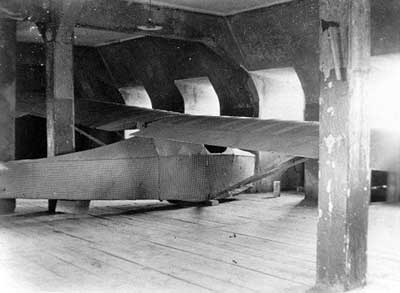 The only known picture of the glider assembled
by Bill Goldfinch and Jack Best in the lower attic above the
chapel: photo taken in April 1945 by an unknown American GI
The only known picture of the glider assembled
by Bill Goldfinch and Jack Best in the lower attic above the
chapel: photo taken in April 1945 by an unknown American GI